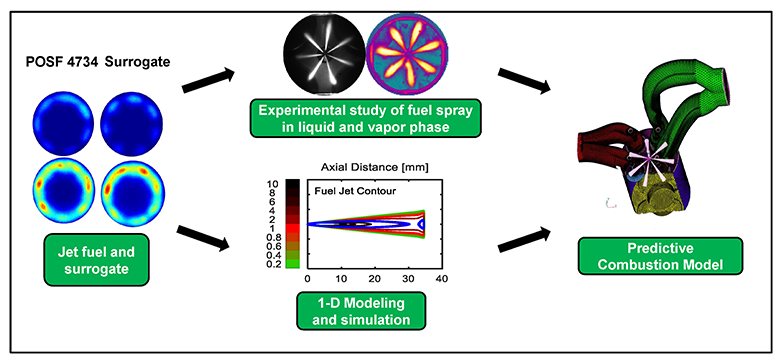Intelligent Power Systems
Annual PlanBoundary Conditions for Predictive Combustion Simulation
Project Team
Government
Peter Schihl, U.S. Army GVSC
Industry
Bruce Geist, Fiat Chrysler Automobiles
Student
Saarang Sharma, Wayne State University
Project Summary
Project began in 2017 and is ongoing. It is part of the Combustion Chemistry Cluster.

A challenge to predictive IC engine simulations is lack of knowledge of thermal boundary conditions. Engine thermal conditions strongly affect most global combustion parameters including ignition delay, combustion phasing, cycle work, and heat loss. The fidelity of even the most robust kinetic, spray and combustion models will be compromised by uncertainties in surface temperatures. Peak pressure, combustion phasing and duration are strongly affected by boundary condition values.
The main research objective is to determine the fuel temperature influence on alternative jet fuel sprays (IPK, S-8, ATJ, HRJ). Knowledge of how this parameter affects global parameters such as liquid lengths, ignition delay and light-off length would guide the development of injection strategies for cold start and identify modifications to spray resulting from blending with alternative jet fuels. An experimental approach is followed comprising parametric optical engine studies applying optical diagnostics. Activities have also been expanded to include spray measurements in a constant volume vessel that allows the investigation of heavy-duty injectors.
The optical engine facilities at WSU and the experimental setups and data obtained by the above described study will be leveraged by the cluster by providing boundary conditions for an IC engine model that will be created using inputs from all pillars of the cluster. This model will reproduce the geometry of the WSU engine, allowing direct comparisons between simulated and experimentally observed parameters. Various optical diagnostics applied at the WSU facility can then be applied to validate global, local, and time-variant combustion parameters of interest. All projects of the cluster have key inputs to the validated model. While this project will provide the model geometry and boundary conditions, the 3-D CFD model will be created by Dr. Violi’s group. The jet fuel surrogate development and kinetic mechanism for the chemistry will be provided by the group of Prof. Boehman. Thus computational and experimental expertise of numerous researchers and projects are brought to bear on the greater objective of advancing the predictive simulation capabilities of the Army.
Previous related publications:
- X. Luo, X. Yu, M. Jansons, “Simultaneous In-Cylinder Surface Temperature Measurements with Thermocouple, Laser-induced Phosphorescence, and Dual Wavelength Infrared Diagnostic Techniques in an Optical Engine”, SAE Congress, Paper no. 2015-01-1658, Detroit, MI, 2015.
- X. Yu, X. Luo, M. Jansons, D. Kim, J. Martz, A. Violi, “A Fuel Surrogate Validation Approach Using a JP-8 Fueled Optically Accessible Compression Ignition Engine”, SAE Congress, Paper no. 2015-01-0906, Detroit, MI, 2015.
- Luo, X., Yu, X., Zha, K., Jansons, M. et al., “In-Cylinder Wall Temperature Influence on Unburned Hydrocarbon Emissions During Transitional Period in an Optical Engine Using a Laser-Induced Phosphorescence Technique”, SAE Int. J. Engines 7(2):2014, doi:10.4271/2014-01-1373.
- Yu, X., Zha, K., Luo, X., Taraza, D., Jansons, M., “Simulation and Experimental Measurement of CO2*, OH* and HCHO* Chemiluminescence from an Optical Diesel Engine Fueled with n-Heptane”, SAE Paper 2013-24-0100.

